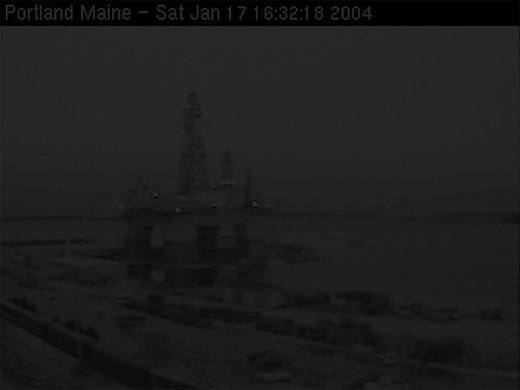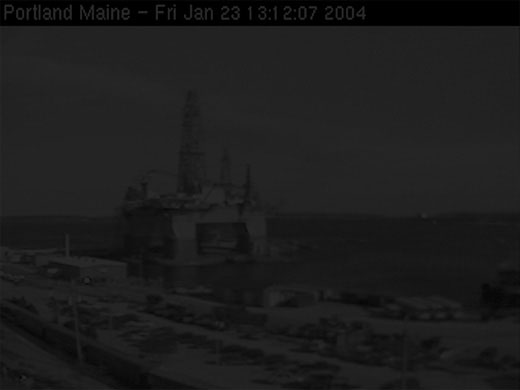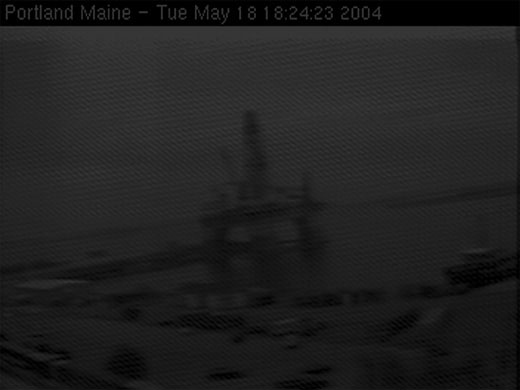
by Gil Blank with Caleb Waldorf
The trauma of lost histories and the joys of JPEGs. A webcam atop the highest hill in Portland, Maine, transports one public place to another, and another.


































Gil Blank: The images come from Portland, Maine. Even the name of the city conveys that singularly American sense of hope; it’s a euphonic conjunction of earth and sea, of nature and possibility. Portland is situated on a hill that looks out in nearly all directions over Casco Bay, which from early in the country’s history played a major role in both commerce and defense. The city is flanked by landscaped promenades that provide views out onto the approaching maritime lanes, and at its highest point, atop Munjoy Hill, there still stands an observatory tower, now defunct beyond its service as a tourist attraction, and as a commemoration of an ideal of the Panopticon that has long since passed. The tower today is magnificent and forlorn, forever looking out onto a view that will never again correspond with it.
At some point, the local landmarks commission decided to place a webcam atop the tower’s cupola, presumably in an attempt to renew its relationship to reality. To me, this gesture is as beautiful as it is pathetic; it also verges on the absurd, considering that a much higher-resolution unit with an only slightly lesser view is broadcasting from a car-rental agency closer to the waterfront. In this case, technology and real estate have outdone natural law and classical convention, yet still the observatory transmits its abject signal from high above the rest of the town, where it’s exposed to the nor’easters and the salt spray, twenty-four hours a day, all year long.
Over the course of 2004, when I first visited the tower in Maine, I found myself returning to its web feed again and again. I was living in New York and suffused with the effects of an urban technological center, which made my cognitive and emotional disconnect from what I was watching unfold in Maine that much more powerful. I was divided in more ways than I could apprehend, and I began to live to some degree through these vicarious images, through a view that was not my own, and that would never regain its originary purpose.
CW: But is there not also a way in which the view transmitted by the webcam perfectly fulfills its “originary purpose”? Is there not a drive, contained within the webcam, to record this view and immediately transmit its altered and always altering representation? It seems to me that the same drive that motivated the city to place the camera in its current location may also have compelled you to look at the images.
GB: I think you’re exactly right about the drive that remains in all such views, and that the webcam now exemplifies. Its virtual omnipresence is the best proof of that universal yearning, and its lo-fi appearance certainly amplifies its democratic affect, as once was true of Brownie camera snapshots and Polaroids. Planted within each of those vernacular forms, though, is the ineluctable depreciation of the earlier, idealistic notions of omniscience, harmony, and consummation that led Portland’s settlers to orient the town in such a way as to provide that “Best General View” over the bay.
CW: In the end, you selected only thirty-five images from a year’s worth of footage. Why did you select these particular thirty-five?
GB: I didn’t plan the time frame; I simply downloaded the first JPEG in January 2004 out of plain interest in it as a picture. I continued downloading just as impulsively over the next twelve months, as the view changed from glaring sunlight to overcast skies to storms that blotted out the feed almost entirely.
Cianbro, an industrial construction corporation, was at that time in the process of building the Amethyst offshore oil-drilling platform down by the docks. One wholly unintentional aspect of my recording was to inscribe the platform as a central figure in most of the pictures. It was nearing completion during the period that I was watching, and was towed away several times for preliminary deep-water testing, which is why the port appears empty in the pictures from May. It was completely gone by September, shipped to its final destination off the coast of Brazil.
I suppose the drilling platform might evoke for some viewers the dominating influence of industry and capital, the displacement of natural and public areas, the worldwide circulation of petrodollars, and so on. Every one of these points is relevant, and indicative of the inherent generosity of photography. But none of them was primary in my thinking during the process, and the platform’s presence only manifested itself to me emblematically, as one more transient feature of the landscape.
CW: Since 2004, this group of images has been exhibited several times, in multiple formats; over that time, you’ve continually rewritten and reprocessed the same images, oftentimes degrading them in the process. The end point seems to be their complete disintegration.
GB: The actions that you’re describing are true, but I’m not sure that the singular or “complete” end you mention pertains. The rewriting and reprocessing are more in line with a course that has no point of origin and can’t ever be wholly completed.
I print the images by a variety of means, with technologies as recent as an ink-jet printer and as outdated as gravure. The impulse has been to resist the abstraction of the image, to “body forth” its meaning by the same industrial and artisanal processes that have subjugated it, while always acknowledging the impossibility of any such effort. Because the printing is performed in successive generations—each new process begins with the already-degraded image left over from the process before it—the effects of reproduction and circulation are slowly overcoming whatever vestige of “original” presence the pictures once had. The tones are getting darker, the details mushy, the digital artifacts coarser.
One term I’ve often thought about in relation to the photographs as a single body is Wiederholungszwang, which translates as “the compulsion to repeat.” It’s a term that was coined by Freud (and later refined by Lacan) to describe a natural response to traumatic experience. If one workable definition of trauma is a missed encounter or lost history, it follows that such an experience can never be adequately recovered or re-presented, only endlessly repeated, even as every iteration carries you further away. Looking at these images reproduced again in a different form, or as new objects, or on a different website—because every JPEG carries within it the code for its further disappearance—each new viewer experiences for herself another step in the same course of separation, which is scripted as a new but diminished event.
CW: The webcam is often viewed as a form of “personal media” that transmits images and sounds of oneself out into the world. The self and space possess an intimate relation to one another in such images—we glimpse a bedroom, a closely cropped face, flat lighting. A dock does not conjure up a sense of intimacy or personal space—it is devoid of character, and built more to accommodate machine than man. What are your thoughts on the city’s employment of the webcam for purposes contrary to those for which it is normally used?
GB: The use you mention for the webcam—transmitting a picture of the self out into the world, with all the connotations of low-grade celebrity and annihilation of personal privacy that it implies—was precisely the opposite of anything that motivated me, as much of a socialized norm as that may now be.
To begin with, the camera’s eye was pointed in the opposite direction: I was on the receiving end of the view, and never had any intention of projecting any aspect of myself or my personal life onto the image at all. But your question is about a much deeper issue, which is where the self—as the embodiment of that original experience we keep coming back to—exists.
Again, the view depicted doesn’t show just any public space, but was considered at one time to be the singular public space, the town’s great vantage, albeit now obscure. That possibility of a view, of some grand vista that would connect and clarify and consummate, as opposed to a mere and transient image, is why I first looked northward to Maine. It implied comprehension and cohesion. I sought that as a way of exceeding myself, of finding the larger social and natural continuities beyond my own fractured existence. It’s important to understand that I didn’t begin saving these pictures with any artistic motivation in mind at all; they were never intended beforehand to become an artwork. I accumulated them out of need, to reckon how exactly the stable sense of self is formed amid a life experience that is at all times on the verge of atomization.
The trend of people whose sole and degraded notion of themselves is formed through their self-projection on a culture already constituted of leftovers and clichés was exactly what I needed to find a way around. I couldn’t truthfully let myself think that I was outside that society’s reach or effect, so I tried instead to transparently reconcile my sense of need with the circumstances as they were.
CW: I’d like to know more about the temporal dimensions of this work. One property of webcam video (and surveillance footage) is its immediacy. The time gap between image capture and playback is virtually nonexistent. What do you find significant about recycling, reusing, and multiplying images whose currency tends to lie in their immediacy?
GB: Because what possible value could such images have if they fail to serve some function that is either informational, surveillant, or sensational? It’s a rhetorical question, since the only way that such instantaneously obsolete things could ever be valued is in terms of their human meaning—by which I’m referring to whatever secondary layer of sense they might carry beyond their existence solely as images. The burden of making sense of them—of translating into a physical form or phenomenon the otherwise abstract dislocation intrinsic to mnemonic devices such as photographs and webcams—in time became what held these images together as a single work.
It is, of course, impossible to speak of “originals” in these images. In any case, the placement, direction, framing, and subject—all the classical criteria by which a pictorial composition is defined as having some correlation to subjective experience—were out of my control. The camera was recording around the clock (and still is); my only remaining determinative criteria were whether to accept the gaze as I found it and when to commit it to memory by downloading its electronic traces. The images remained that way for several years: immaterial, private, and without any intrinsic meaning beyond their designation as numerical bits on a hard drive. Even as first-generation downloads, the files were already abstractions of a view that itself was formed beyond my control, without my involvement or presence. And yet that urge to make some sense out of a shattered history persisted, if only to form a model that could parallel the secondary experience of that dissolution.
CW: In the mid-’90s, Marc Auge coined the term “non-places” to refer to temporary spaces that are not substantial enough to be regarded as “places.” In Non-Places: Introduction to an Anthropology of Supermodernity, he writes, “Place and non-place are rather like opposed polarities: the first is never completely erased, the second never totally completed; they are like palimpsests on which the scrambled game of identity and relations is ceaselessly rewritten.” The original images you captured (which picture a non-place) have been processed, distributed, and redistributed, as has the project as a whole. I get the sense that your work visually maps the erosion of the traditional role of the camera, and its replacement by the technologies that have been instrumental in constructing the image of the non-place.
GB: Or maybe my work implicates photographic vision as having carried the germ of this alienation all along. And if so, then it also implies the responsibility for acknowledging the ambiguity latent in all such histories.
Gertrude Stein expressed this sentiment perfectly: “There is no there there.” The difference is, I think, instructive. Stein’s levity and lyricism anticipated our condition of fragmentation but employed a subjective, creative means—in her case, literature—to reestablish an understanding of it that predates us, and that could just as easily be inferred from similar but much earlier works. This sense of continuity—that the particular circumstances of modernity may be novel, but its fundamental burdens are less so—must afford some worthwhile shelter amid a rhetoric of the arts that can verge on the nihilistic. That ennobled despair seems little different to me than the societal and historical forces it critiques.
I think the responsibility, then, is to openly acknowledge the limitations of a situation, without capitulating either to ideals or the ease of cynicism; to form a means of reckoning that is not without hope, but past the need for it.
CW: I’m curious what you think this piece would be without the multitude of (re)printed images? In other words, can we capture something about them through their own erasure?
GB: I wouldn’t consider the process an erasure, which implies a deliberate negation and a fatalism that has no place in the pictures. I think the way that you described it earlier, as disintegration, is more apt, as it suggests an effect that’s incidental but accepted. The process then becomes a matter of witness, and of allowing the images to register another unexpected and ancillary index, as photographs always and naturally do.
I think what you’re rightly seeking is that secondary layer of meaning, which you can think of as the way that the photographs function, rather than what they simply portray. Despite the fact that they depict a certain time and place and social circumstance, all of which carry their own intrinsic interest, I grant you that my own reasons for looking at that early web feed may have absolutely no bearing on your own experience of the images.
So then what possible operation could such images perform beyond solipsism? If there is any persistent meaning to be found in them, it has to be because the process of their dissemination—of the earlier downloading, of their further reproduction and dissolution, and of your eventual and momentary custody—becomes an ongoing model of contemporary social experience, rather than its mere illustration. If that model arrives debased, it must be all the more knowable and believable for its indirection.